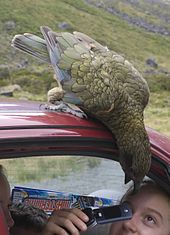 | |
| A vicious killer on the prowl. |
Most naturalists dismissed the idea, saying it was impossible for birds, (even 19-inch long birds that travel in packs wielding razor claws and bone-snapping beaks,) to kill healthy sheep. Some conceded that maybe the livestock were dying naturally and the Kea, along with insects and other scavengers, would mutilate them post-mortem. But this theory simply didn't justify why perfectly normal animals were dropping dead out of nowhere: primarily sheep, but also dogs, cats, rabbits and even horses. For decades this remained a hotly debated phenomenon.
It wasn't until 1993 that night vision cameras finally captured one of the deadly assaults. There, in the still of night, came the parrots. Approximately three or four of them descended into the field and hopped menacingly towards their victim. The Kea leapt onto a ewe's back and tore unrelentingly at her hide, her short neck and stumpy limbs leaving her powerless to stop them. The footage revealed that the Kea were actually digging around for the sheep's fat, just underneath her skin, and opened some impressive wounds in doing so. Injured sheep rarely died right away, but would eventually succumb to infection or gradual blood loss. This tape proved that Kea would attack perfectly healthy sheep for food, and it's not unlikely that they prey on other domesticated critters as well. Therefore, Kea are the only parrots in the world known to successfully hunt animals many times their own size.
 |
| --OH JESUS CHRIST! |
 |
| Aww, Polly wanna-- |
So there you have it, folks: New Zealand's adorable slaughter parrots. They're intelligent, they're inventive, and they hunger for raw mammalian flesh. How long do you think it'll take before the rest of their avian brethren join forces and decide to go Hitchcock on our flabby, unprotected human asses?
UPDATE: We now have video of this grizzly phenomenon. Fair warning, it's pretty damn creepy.

![[Figure 4 (Diagram of short- (left) and long-tongued (right) woodpecker
skull and hyoid apparatus.)]](http://www.talkorigins.org/faqs/woodpecker/flickerfinal4.jpg)
